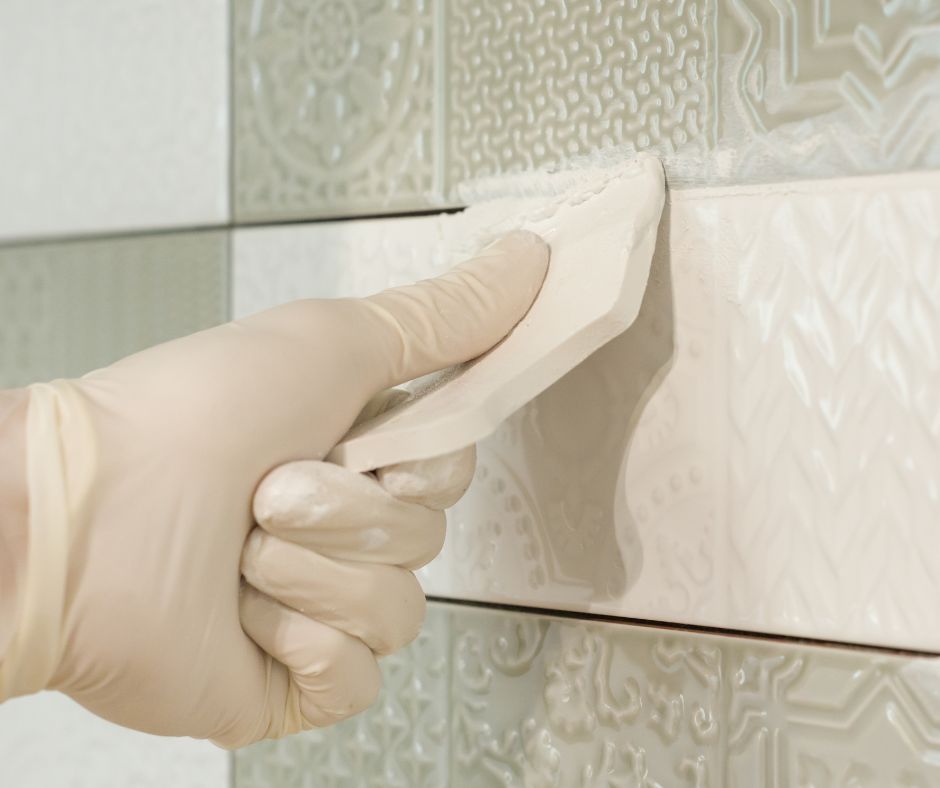Have you noticed unsightly holes in your shower tile grout?
Don't panic! While they may detract from the overall appearance of your shower, these issues are manageable. However, it's essential to address them promptly to prevent more significant complications in the future.
Here's the silver lining – These holes are easily repairable!
This guide will walk you through the step-by-step process to effectively fix holes in your shower tile grout. Additionally, we'll delve into the underlying causes of grout damage and share preventive measures to help you avoid these issues in the future.

Step-by-Step Guide to Fix Holes in Shower Tile Grout
Repairing those grout holes may seem daunting, but it's straightforward. Allow me to guide you through the necessary steps, ensuring your shower looks pristine again.
#1 Collect Essential Tools for Grout Repair
Before diving into the repair work, let's gather all the necessary supplies to make the task efficient and effective. You will need:
- Grout removal tools
- Caulk gun
- Grout that matches your existing tile color
- Grout float for application
- A sponge for cleanup
- A bucket of water for rinsing
- Masking tape for neat edges
Don't forget to wear gloves and safety glasses for protection while you work.
Having all your tools organized before starting will streamline the entire process, making it less stressful and more enjoyable.
Also Read: Epoxy Grout VS Cement Grout
#2 Prepare Your Shower Area for Grout Repair
Now that the tools are ready, it's time to prepare the area. Begin by applying masking tape around the grout lines where the holes are located.
This will ensure the new grout stays in place, creating a clean and professional finish.
Next, take your grout removal tool and carefully extract the old, damaged grout. Be gentle during this process to avoid scratching the tiles, and if you're working in a shower, be cautious not to damage the waterproof membrane beneath the tiles.
This preparation step is crucial, providing a clean and stable surface for the new grout to adhere to effectively.
Also Read: Why Grout Gets Stained And Damaged
#3 Thoroughly Clean the Workspace Before Grouting
After removing the old grout, it's time to clean the area. Use a slightly damp cloth to wipe down the surface, eliminating all dust and debris from the grout removal process.
It's vital to allow the area to dry completely before applying new grout; a dry surface will enhance the adhesion of the new grout.
#4 Skillfully Apply New Grout for a Seamless Finish
Now comes the exciting part! Prepare your grout according to the instructions on the packaging.
You want to achieve the perfect consistency – not too watery and not overly thick.
Utilize your grout float to apply the new grout over the holes, ensuring you push it in at an angle. This technique helps fill all gaps and creates a smooth finish.
Once the holes are filled, use the float to level the surface and remove any excess grout, ensuring it looks tidy and professional.
#5 Carefully Wipe Away Excess Grout for a Clean Look
After allowing the grout to set for a short period, take your damp sponge and gently wipe away the excess grout.
Be sure to rinse the sponge frequently. You want to avoid allowing grout to dry on it, which can complicate the cleaning process.
This step requires patience, but achieving that polished, professional appearance is worth the effort. Take your time to ensure perfection before letting everything dry entirely and removing the masking tape.
Also Read: Regrouting Your Bathroom Grout
#6 Optional Step: Seal the Grout for Enhanced Longevity
If you're interested in enhancing the durability of your grout, consider applying a grout sealer.
This step isn't mandatory, but it can significantly protect against moisture and stains, extending the life of your repair.
If you choose to seal the grout, wait a few days for it to fully cure before applying the sealer.
Follow the manufacturer's instructions for the best results, and you'll add an extra layer of protection to keep your grout looking fresh and vibrant.

Understanding the Causes of Grout Damage and Preventing Future Issues
Have you ever wondered what causes those unsightly holes in the first place?
The primary culprits are usually moisture and aggressive cleaning methods. Grout is inherently porous and can deteriorate over time, particularly if not sealed adequately. Moreover, showers are subjected to constant water exposure and frequent cleaning.
This damage can also occur due to your house's natural settling over time, causing minor shifts that result in cracks or holes in the grout.
Consider sealing your grout after installation or repair to prevent future holes from appearing.
Additionally, using gentle cleaning products can prolong the life of your grout. Avoid harsh chemicals that can degrade the grout over time.
Regularly checking your shower grout for any signs of damage can also be beneficial.
Addressing any issues as soon as they arise will help prevent them from worsening.
Essential Takeaways for Successful Grout Repair
Repairing holes in your shower tile grout is entirely achievable on your own, and it can prevent more significant, costly issues in the future.
We are here to assist if you prefer to have professionals handle this task. We can efficiently complete the regrouting process and relieve you of the hassle.
Regardless of your choice – addressing those holes will help maintain your shower's functionality and aesthetic appeal for years to come!
What to Do If Your Contractor Left Holes in Your Grout?
If you've recently had renovations in your bathroom and noticed holes in the grout, contacting your contractor without delay is essential. A reputable professional should ensure that no holes or imperfections are left behind in the grout.
Most reliable contractors will be more than willing to return and rectify these issues.
How to Repair Pin Holes in Grout Effectively?
To address pin holes in the grout, start by cleaning the area and lightly dampening the surrounding grout. Next, press a small amount of grout into the holes, smoothing the patched area with your finger for a seamless finish.
What's the Process for Repairing Missing Grout in the Shower?
Fixing missing grout is quite similar to repairing holes. Ensure the area is thoroughly cleaned, apply new grout to the affected spots, and smooth it out using your grout float. Remove any excess grout and allow it to dry completely for optimal results.




I can totally relate to dealing with grout issues! Just a few weeks ago, I noticed some holes in my shower grout, and I was initially overwhelmed. After a bit of research, I realized how essential proper maintenance is. It got me thinking about how often something as small as grout can have such a big impact on the bathroom’s overall look and even on hygiene.
Dealing with grout issues can really be an eye-opener. It’s fascinating how something that seems small and often ignored can make such a significant difference in the overall look and feel of a bathroom. When we think about home maintenance, grout doesn’t always top the list, but it certainly deserves more attention than it usually gets.
It’s interesting you mentioned feeling overwhelmed by the grout issues. It’s easy to overlook something so small, yet it can silently undermine the entire vibe of a bathroom. That sense of panic can creep in when we see those little holes, especially knowing how quickly things like mold or mildew can take hold if left unchecked.
I can definitely relate to that feeling of being overwhelmed by grout issues. It really is surprising how something that seems so minor can create such a bigger problem. I had a similar experience in my bathroom a few months ago. I noticed some small cracks, and I kept putting off addressing them. It wasn’t until I started noticing a faint musty smell that I really panicked. I found myself diving deep into research about mold prevention and the best cleaning techniques, and it led me down a rabbit hole of understanding how vital maintaining that small space is for overall health.
I completely relate to that feeling of being overwhelmed when you first spot those grout issues. It’s interesting how something that seems so minor can really affect the vibe of the whole space, isn’t it? I’ve spent more time than I care to admit trying to restore grout in my own bathroom and have learned firsthand that maintenance is key—not just for aesthetics but also for hygiene.
It’s so refreshing to see a guide on grout repair! I recently faced a similar issue in my shower, and while it felt daunting at first, I learned that these repairs can be a surprisingly manageable DIY project. I think what’s often overlooked is how much the state of our home’s fixtures can affect our mental wellbeing; a clean and well-maintained shower can make such a difference in our daily routines.
Repairing grout holes in shower tiles is often seen as a straightforward maintenance task, yet it highlights a more extensive issue that many homeowners face: the long-term upkeep of our living spaces. I’ve dealt with similar grout issues in my own bathroom, and while the repair process was indeed manageable, it made me consider the quality of materials we use and the environmental factors that contribute to such wear and tear.